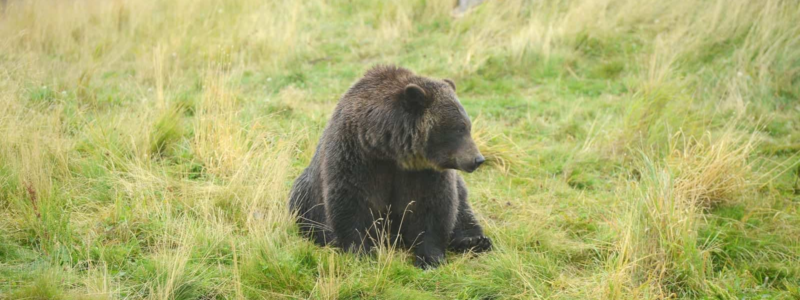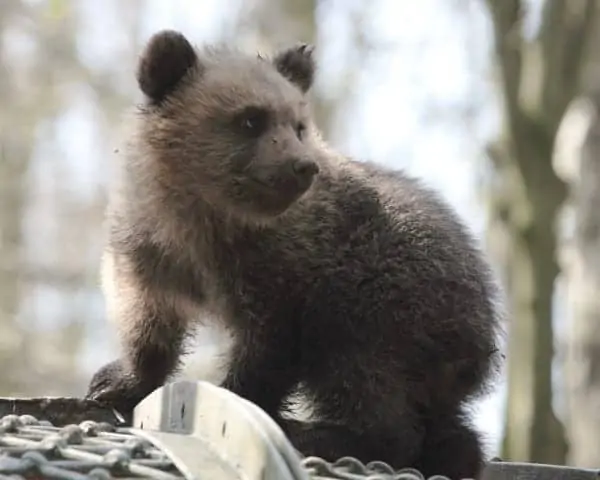
The black bear is the only species of bear found in Minnesota. If you spot a bear while visiting Lake Superior’s North Shore, it’s almost guaranteed to be a black bear. Generally, you will find them in heavily forested areas, like the Superior National Forest and Boundary Waters Canoe Area Wilderness. Black bears are 5-7 feet in length and can weigh anywhere from 150-500 pounds. They follow their noses and use their mental maps of the landscape to locate food sources. Because of this, black bears can travel a fair distance each day along a similar route looking for food. Likewise, the same bears tend to frequent the same areas year after year, leading to some notable bear encounters!
Lutsen Bear Encounters
 Black bears usually try to avoid people, but sometimes come in conflict with humans when they eat crops, destroy apiaries, or break into garbage cans and birdfeeders. Along the North Shore, residents usually pull in bird feeders and secure trash bin and compost piles in the summer and fall months to avoid attracting bears. Still, hungry bears will do what it takes to get a good meal! In October of 2017, Cascade Vacation Rentals had its own bear rescue happen at our dumpster in Lutsen! That story made international news and was featured by some well-known outlets including Inside Edition and The Daily Mail.
Black bears usually try to avoid people, but sometimes come in conflict with humans when they eat crops, destroy apiaries, or break into garbage cans and birdfeeders. Along the North Shore, residents usually pull in bird feeders and secure trash bin and compost piles in the summer and fall months to avoid attracting bears. Still, hungry bears will do what it takes to get a good meal! In October of 2017, Cascade Vacation Rentals had its own bear rescue happen at our dumpster in Lutsen! That story made international news and was featured by some well-known outlets including Inside Edition and The Daily Mail.
Then, in 2019 and again in 2020, a mama bear and four baby cubs were seen frequently in the Lutsen area. The family often found their way to our dumpsters. Luckily, they were always able to get back out without assistance! In 2020 we built an electric fence around our dumpsters to help keep the thrifty bears away. However, reports of bears breaking into dumpsters and even homes are reported every year in the area. In 2024, a baby and mama black bear were frequently spotted in the areas of the Poplar River Condos at Lutsen and the burned remains of Lutsen Resort.
It’s important to always be Bear Aware, but especially in the early spring when they first awaken and late fall as they try to fatten up for hibernation!
Be Bear Aware
So what does it mean to be Bear Aware? Simply, it’s just being aware that there are black bears found throughout Northern Minnesota. In the spring, hungry bears emerge from their winter hibernation looking for food. Mother bears will birth their young during hibernation and will be hungry and on alert as she brings her new cubs out to explore for the first time. During the fall, they are doing their best to fatten up for their winter hibernation and tend to move closer and closer to the most convenient food source they can find. Usually, this means finding their way into areas populated by humans in search of food scraps.
This could mean digging through a dumpster- so always use caution when opening up a dumpster, especially if there are no intact bear bars. It also means refraining from leaving food outside on decks and patios, as well as not leaving food in your car! Yes, bears love breaking into cars to sneak snacks carelessly left behind. If preparing a meal outside on a BBQ, be sure to clean the grates well and remove food scraps.
Be sure to keep dogs on a leash, even if just around your property to use the bathroom, as a dogs are prone to chase or otherwise agitate bears passing through. It is especially important to keep dogs on a leash while hiking in wooded areas.
And while it should go without saying, sadly, we have to say it. Do not pack or store a firearm or weapon in the same bag as your food. Yes, this happened back in 2021. While “Bear briefly becomes armed after stealing camper’s gun in Boundary Waters” makes for a great news headline (and maybe a movie spin off?), the situation could have been very bad. Please, do not do this.
What To Do if You Encounter a Black Bear
If you do happen to see a black bear near your home, rental, car, or when out hiking, don’t panic! Black bears are typically docile and not aggressive towards humans unless provoked or protecting young. Random bear encounters in the wild are rare as bears avoid areas of heavy human traffic.
If you do come across a bear while outdoors, most black bears can be easily scared away with the following approach. Keep calm, never turn your back on a black bear, and slowly move to a safe, enclosed area. If slowly moving to a safe area is not possible, stand and face the bear directly. Never run away from or approach him. Make yourself look as big as possible by spreading your arms or, better yet, a coat or sweater. Make as much noise as possible by yelling, clapping your hands over your head, or using other noisemaking devices. While this is very rare, if the bear is undeterred and approaches you, begin to move away quickly while continuing to look large and threatening. The bear will likely be afraid of you and move on.
If they are eating, however, they may decide to delay their departure. It has happened, on very rare occasions, when bears get used to people. Even after making a ruckus, they may not leave until they have finished eating. Practice patience and wait for their departure, then clean up any remaining food scraps so that they do not return later.
It should also go without saying, but refrain from petting or trying to hug the bear. While friend shaped, bears are wild animals, not our friends. Never try to pet, feed, or interact with a black bear. Appreciate their beauty from safe distance, preferably in an enclosed area.
More About Black Bears – Habitat
 Black bears like large forests with an abundance of fruits, nuts, and barriers. They can also be found in lowlands and wetlands with succulent vegetation near pools and streams where they can cool off. Mothers with cubs tend large trees ( like white pines) for bedding sites and refuge for her cubs.
Black bears like large forests with an abundance of fruits, nuts, and barriers. They can also be found in lowlands and wetlands with succulent vegetation near pools and streams where they can cool off. Mothers with cubs tend large trees ( like white pines) for bedding sites and refuge for her cubs.
Hibernation
Black bears hibernate in their dens for during winter for as long as six or seven months living off stored body fat. During this time they do not eat, drink, urinate, or defecate. They wake in spring with little loss of muscle mass or strength.
Reproduction
Black bears mate during May-July. Newborn cubs are typically born in January and do not hibernate. The mother provides all their nourishment while she is hibernating. Litters are most often of three cubs weighing about 3 pounds, which by mid-March weigh 5-6 pounds. They leave the den usually in early April and remain with the mother for 17 months, hibernating with her when they are 1 year old. Male bears play no role in raising young, and may even kill the cubs if given the chance.
Food
The Black Bear prefers nuts, acorns, fruit, insects, and succulent greens. Meat and less succulent greens are eaten when preferred foods are scarce.
Spotting One
The good news is, the black bear population on the North Shore is thriving! Leave a bag of trash outside for the night and you may find yourself having an early morning bear encounter and have to clean up the trash in the morning (seriously, don’t do that!). Rather, take a drive on a remote road or along the Gunflint Trail. You may just spot on running across the road or hanging out along the treeline. As they typically don’t like people, bears are more likely to be seen in remote areas. They are also more likely to come out at dawn and dusk.
